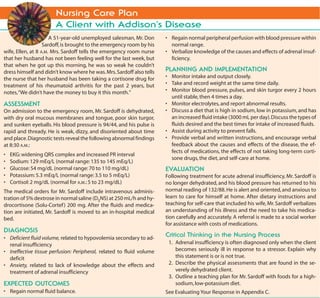
Sample NCP for Addisons disease
- 1. 468 UNIT IV / Responses to Altered Endocrine Function Nursing Care Plan A Client with Addison’s Disease A 51-year-old unemployed salesman, Mr. Don • Regain normal peripheral perfusion with blood pressure within Sardoff, is brought to the emergency room by his normal range. wife, Ellen, at 8 A.M. Mrs. Sardoff tells the emergency room nurse • Verbalize knowledge of the causes and effects of adrenal insuf- that her husband has not been feeling well for the last week, but ficiency. that when he got up this morning, he was so weak he couldn’t dress himself and didn’t know where he was. Mrs. Sardoff also tells PLANNING AND IMPLEMENTATION the nurse that her husband has been taking a cortisone drug for • Monitor intake and output closely. treatment of his rheumatoid arthritis for the past 2 years, but • Take and record weight at the same time daily. notes,“We didn’t have the money to buy it this month.” • Monitor blood pressure, pulses, and skin turgor every 2 hours until stable, then 4 times a day. ASSESSMENT • Monitor electrolytes, and report abnormal results. On admission to the emergency room, Mr. Sardoff is dehydrated, • Discuss a diet that is high in sodium, low in potassium, and has with dry oral mucous membranes and tongue, poor skin turgor, an increased fluid intake (3000 mL per day).Discuss the types of and sunken eyeballs. His blood pressure is 94/44, and his pulse is fluids desired and the best times for intake of increased fluids. rapid and thready. He is weak, dizzy, and disoriented about time • Assist during activity to prevent falls. and place. Diagnostic tests reveal the following abnormal findings • Provide verbal and written instructions, and encourage verbal at 8:30 A.M.: feedback about the causes and effects of the disease, the ef- fects of medications, the effects of not taking long-term corti- • EKG: widening QRS complex and increased PR interval sone drugs, the diet, and self-care at home. • Sodium: 129 mEq/L (normal range: 135 to 145 mEq/L) • Glucose: 54 mg/dL (normal range: 70 to 110 mg/dL) EVALUATION • Potassium: 5.3 mEq/L (normal range: 3.5 to 5 mEq/L) Following treatment for acute adrenal insufficiency, Mr. Sardoff is • Cortisol: 2 mg/dL (normal for A.M.: 5 to 23 mg/dL) no longer dehydrated, and his blood pressure has returned to his The medical orders for Mr. Sardoff include intravenous adminis- normal reading of 132/88. He is alert and oriented, and anxious to tration of 5% dextrose in normal saline (D5NS) at 250 mL/h and hy- learn to care for himself at home. After dietary instructions and drocortisone (Solu-Cortef ) 200 mg. After the fluids and medica- teaching for self-care that included his wife, Mr. Sardoff verbalizes tion are initiated, Mr. Sardoff is moved to an in-hospital medical an understanding of his illness and the need to take his medica- bed. tion carefully and accurately. A referral is made to a social worker for assistance with costs of medications. DIAGNOSIS • Deficient fluid volume, related to hypovolemia secondary to ad- Critical Thinking in the Nursing Process renal insufficiency 1. Adrenal insufficiency is often diagnosed only when the client • Ineffective tissue perfusion: Peripheral, related to fluid volume becomes seriously ill in response to a stressor. Explain why deficit this statement is or is not true. • Anxiety, related to lack of knowledge about the effects and 2. Describe the physical assessments that are found in the se- treatment of adrenal insufficiency verely dehydrated client. 3. Outline a teaching plan for Mr. Sardoff with foods for a high- EXPECTED OUTCOMES sodium, low-potassium diet. • Regain normal fluid balance. See Evaluating Your Response in Appendix C. DISORDERS OF THE PITUITARY GLAND The pituitary gland produces hormones that affect multiple THE CLIENT WITH DISORDERS OF THE body systems through regulation of endocrine function. Target ANTERIOR PITUITARY GLAND tissues include the thyroid, adrenal cortex, ovary, uterus, mam- mary glands, testes, and kidneys. Disorders result from an ex- cess or deficiency of one or more of the pituitary hormones due Hyperfunction of the anterior pituitary gland, characterized to a pathologic condition within the gland itself or to hypothal- by excess production and secretion of one or more trophic amic dysfunction. hormones, is usually the result of a pituitary tumor or pitu- Although disorders of the pituitary cause diverse and seri- itary hyperplasia. The most common cause of hyperpitu- ous problems, they are not as common as disorders of other en- itarism is a benign adenoma. The manifestations result from docrine glands. Hyperpituitarism and hypopituitarism are dis- an excess of growth hormone (GH), prolactin (PRL), or cussed in this section. ACTH.
